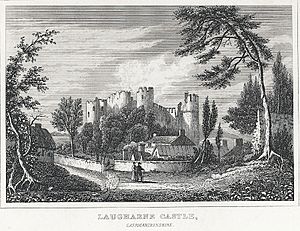Laugharne Castle facts for kids
Quick facts for kids Laugharne Castle |
|
|---|---|

Laugharne Castle 2015
|
|
| General information | |
| Architectural style | Castle |
| Town or city | Laugharne, Carmarthenshire |
| Country | Wales |
| Coordinates | 51°46′10″N 4°27′43″W / 51.769427°N 4.462016°W |
| Completed | 12th century |
Laugharne Castle (Welsh: Castell Talacharn) is a historic castle located in Laugharne, Carmarthenshire, Wales. It sits right on the estuary of the River Tâf. This impressive building started as a simple castle in 1116. Over the years, it was rebuilt as a strong Norman fortress. Later, it became a fancy Tudor manor house in the 1500s. The castle played a part in the English Civil War, changing hands twice before being captured by Parliament's army in 1644.
Contents
A Look Back: Laugharne Castle's Story
Laugharne Castle has a long and exciting history, full of battles and changes.
Early Days and Norman Power
The first castle here was built around 1116. It was looked after by a Welshman named Bleddyn ap Cedifor. Later, in 1171–1172, an important meeting happened here. Henry II of England and Rhys ap Gruffudd, a powerful Welsh prince, met to agree on a peace treaty.
When King Henry II died in 1189, Rhys ap Gruffudd quickly took over Laugharne Castle. He also captured nearby castles like St Clears and Llansteffan. The castle might have been burned down during this time. But it was soon rebuilt by the Normans, who were strong rulers.
In 1215, another famous Welsh leader, Llywelyn the Great, captured Laugharne Castle. This was part of his big campaign across South Wales. By 1247, the castle was given to the De Brian family. However, in 1257, Guy de Brian was captured at the castle by Llywelyn ap Gruffudd, and the castle was destroyed again.
Rebellions and Royal Connections
In 1403, the famous Welsh rebel Owain Glyndŵr faced a setback at Laugharne. He was tricked into an ambush and lost many of his men. A local fortune-teller warned him to leave, and he did. After this, his rebellion slowly faded away.
In 1584, Queen Elizabeth I gave Laugharne to Sir John Perrott. People said he might have been the secret son of Henry VIII. Sir John changed the castle a lot. He turned it from a military fort into a grand Tudor mansion, making it much more comfortable to live in.
The English Civil War and Beyond
During the English Civil War in 1644, Laugharne Castle was first taken by the Royalists, who supported the King. But then, the Parliamentary forces, led by Major-General Rowland Laugharne, attacked it. After a week-long siege, where cannons heavily damaged the castle, the Royalist soldiers gave up.
To stop anyone from using the castle as a fort again, parts of it were deliberately destroyed. Around 1730, a new house called Castle House was built nearby. The castle itself was left as a beautiful ruin. In the early 1800s, the outer area of the castle was turned into lovely formal gardens.
Later, famous writers found inspiration at Laugharne. Richard Hughes rented Castle House in the 1930s and 1940s. He wrote his novel In Hazard in a small building in the garden overlooking the river. The famous Welsh poet Dylan Thomas also stayed with Hughes and worked in the same spot on his book Portrait of the Artist as a Young Dog.
Exploring the Castle's Structure
The castle you see today shows many layers of its past. It started as a simple earthwork (a mound of earth) and grew into a grand Tudor mansion.
Building Through the Centuries
There isn't much left of the very first earth bank or the first stone hall. The two strong round towers you can see now were built in the late 1200s. Some of the original outer walls, called curtain walls, from that time are also still standing.
The tower on the northwest side was like a main tower, or keep. It also protected the entrance gate. This tower has a rounded roof. The other tower, which had three floors, has partly fallen down. The extra floors and a circular staircase were likely added in the late 1200s. A new hall was also built against the south curtain wall. The outer area, which probably had wooden defenses, might also be from this period. More work in the late 1200s included another round tower at the southwest corner and a stronger main gatehouse. The outer defenses were also rebuilt with stone.
Later Changes and Tudor Style
In the mid-1300s, the height of the curtain walls at the southwest corner was increased. The round tower and the inner gatehouse were also made taller. You can easily spot these changes because a greenish stone was used, which looks very different from the red sandstone used in the older parts.
In the 1500s, the castle was completely changed into a large Tudor mansion. It got more comfortable living areas and decorative battlements (the top parts of a castle wall) added to the curtain walls. Digging at the site has shown parts of the Tudor cobbled courtyard, a stone kitchen floor, and the layouts of the building from different time periods.
Visiting Laugharne Castle
Laugharne Castle is a very important ancient monument and is listed as a Grade I listed building. This means it's one of the most important historic buildings in Wales.
The castle is looked after by Cadw, which is the Welsh government's historic environment service. It's open for visitors from spring to autumn. There's parking nearby, and parts of the castle are accessible for wheelchair users, though some areas have slopes. There's also a visitor centre and accessible toilets. Just remember, children are not allowed to visit without an adult.


